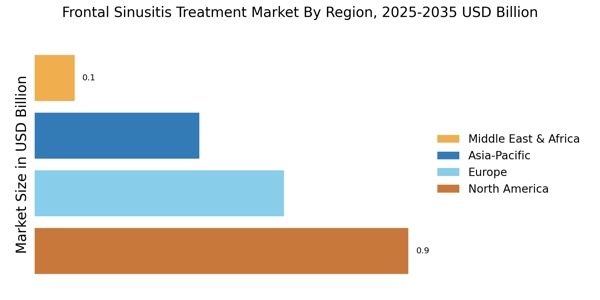Rising Healthcare Expenditure
An increase in healthcare expenditure across various regions is fostering growth in the Frontal Sinusitis Treatment Market. As governments and private sectors allocate more resources to healthcare, patients gain better access to treatment options. This trend is particularly evident in developed nations, where healthcare spending has seen a consistent rise. According to recent data, healthcare expenditure in the United States reached approximately 18% of GDP, indicating a strong commitment to improving health services. This financial support enables the development and availability of innovative treatments for frontal sinusitis, thereby expanding the market and enhancing patient care.
Growing Awareness and Education
The heightened awareness and education surrounding sinusitis and its treatment options are driving the Frontal Sinusitis Treatment Market. Public health campaigns and educational initiatives by healthcare organizations aim to inform individuals about the symptoms and potential complications of untreated sinusitis. This increased awareness encourages patients to seek medical advice sooner, leading to higher treatment rates. Additionally, healthcare professionals are increasingly focusing on educating patients about the importance of managing frontal sinusitis effectively. As more individuals become informed about their health, the demand for effective treatment solutions within the Frontal Sinusitis Treatment Market is likely to rise.
Advancements in Medical Technology
Technological innovations in medical devices and treatment methodologies are significantly influencing the Frontal Sinusitis Treatment Market. The development of advanced imaging techniques, such as CT scans and MRI, enhances diagnostic accuracy, allowing for more targeted treatment approaches. Furthermore, minimally invasive surgical techniques, including endoscopic sinus surgery, have gained traction, offering patients quicker recovery times and reduced complications. The integration of these technologies not only improves patient outcomes but also drives the demand for specialized treatment options within the market. As healthcare systems continue to adopt these advancements, the Frontal Sinusitis Treatment Market is poised for substantial growth.
Increasing Prevalence of Sinusitis
The rising incidence of sinusitis, particularly frontal sinusitis, is a primary driver for the Frontal Sinusitis Treatment Market. Studies indicate that sinusitis affects approximately 29 million individuals annually in the United States alone. This growing patient population necessitates effective treatment options, thereby propelling market growth. The increasing awareness of sinusitis symptoms and the importance of timely intervention further contribute to the demand for treatment solutions. As healthcare providers emphasize the need for early diagnosis and management, the Frontal Sinusitis Treatment Market is likely to expand, accommodating a wider range of therapeutic options to address the needs of patients suffering from this condition.
Shift Towards Personalized Medicine
The shift towards personalized medicine is emerging as a significant driver in the Frontal Sinusitis Treatment Market. Tailoring treatment plans to individual patient needs enhances the effectiveness of therapies and improves patient satisfaction. Advances in genetic research and biomarker identification allow for more precise treatment strategies, which are particularly beneficial for patients with chronic frontal sinusitis. This trend is supported by a growing body of evidence suggesting that personalized approaches can lead to better clinical outcomes. As healthcare providers increasingly adopt personalized treatment modalities, the Frontal Sinusitis Treatment Market is expected to experience robust growth.


















Leave a Comment